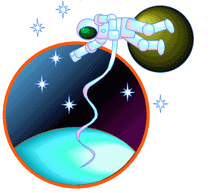
How Does Life Begin and Develop?
Goal
1
How
Life Arose on Earth
Goal
2
Organization of Matter into Living Systems
Goal
4
Coevolution of the Biosphere and the Earth
Does Life Exist Elsewhere in the Universe?
Goal
7
Signature of Life on Other Worlds
Goal
8
Life on Mars and Europa
What is Life's Future on Earth and Beyond?
Goal
9
Environmental Change on Earth
Goal
10
Terrestrial Life in Space
Question: What is Life's
Future on Earth and Beyond?
Goal
10: Understand the Response of Terrestrial Life to Conditions in Space
or on Other Planets

Study the adaptation and evolution of Earth life in other environments,
including the Space Station and Mars, and investigate the possibility
of bioengineering ecosystems for better adaptation to alien environments.
All life that we know (that is, terrestrial life) has developed in a one-gravity field, protected by the Earth's atmosphere and magnetic fields. What happens when terrestrial life is moved off its home planet and into space or to the Moon or Mars, where the environment is very different from that of Earth? Can organisms and ecosystems adapt to a completely novel environment and live successfully over multiple generations? Are alternative strategies practical, such as bioengineering organisms for specific environments? The results from attempting to answer such questions will determine whether life is strictly a planetary phenomenon or can expand its evolutionary trajectory beyond its place of origin.
Background
All life that we know evolved on Earth. Now, for the first time in human history, we have the capability to intentionally move life beyond our home planet. Organisms have been carried to other surfaces in our solar system and have survived; yet they have not proliferated there. Environmental conditions on other planets provide potentially insurmountable challenges for evolution of terrestrial organisms. Delineating the mechanisms that organisms use to adapt to environmental extremes on Earth or simulated environments for other planets will provide insights into the environmental envelope that allows life to exist. The critical near-term questions to be answered are whether (and what kinds of) organisms live reproductively successful lives over multiple generations beyond Earth, and what genotypic changes (changes in the genes or DNA sequence) and phenotypic changes (changes appearance or physiology) result. The International Space Station will provide a testbed for studying evolution and ecological interactions of organisms. These studies will determine if simple organisms and their ecosystems evolve.